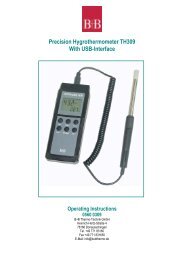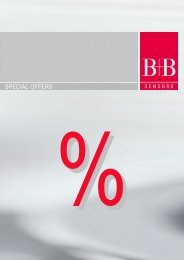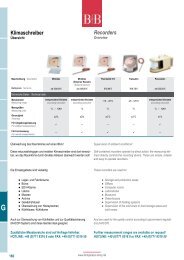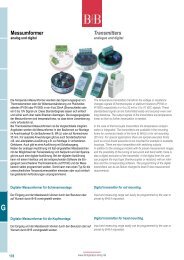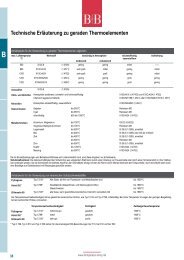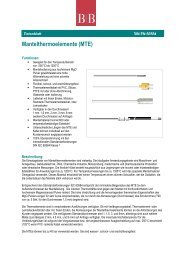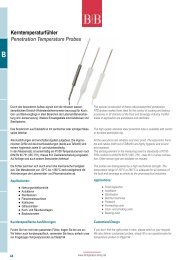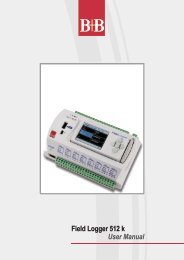B - Temperatur-Shop
B - Temperatur-Shop
B - Temperatur-Shop
Create successful ePaper yourself
Turn your PDF publications into a flip-book with our unique Google optimized e-Paper software.
B<br />
Technische Erläuterungen Thermoelemente<br />
Technical Notes Thermocouples<br />
Technische Erläuterungen Thermoelemente Technical Notes Thermocouples<br />
Funktion und Aufbau von Thermoelementen<br />
Function and construction of thermocouples<br />
Thermoelemente werden durch eine elektrisch leitende Verbindung zweier verschiedener<br />
Metalle (Legierungen) gebildet. An der Verbindungsstelle entsteht eine temperaturabhängige<br />
Kontaktspannung. Diese Kontaktspannung (Thermospannung) hängt von<br />
den beiden Legierungen und der <strong>Temperatur</strong>differenz zwischen der Verbindungsstelle<br />
(Messstelle) und den offenen Enden (Anschlussstelle) ab. Die Enden müssen mit<br />
identischen Legierungen (Thermoleitung) oder mit Legierungen, die die gleichen thermoelektrischen<br />
Eigenschaften (Ausgleichsleitung) haben wie die Thermoelementdrähte,<br />
weitergeführt werden, bis zu einer Vergleichsmessstelle bekannter <strong>Temperatur</strong>. Bei den<br />
meisten Auswertegeräten mit einem Thermoelementeingang wie Reglern, Anzeige- oder<br />
Registriergeräten ist die Vergleichsstelle bereits integriert.<br />
Farbkennzeichnung für Thermoelemente Color Codes for Thermocouples<br />
Element<br />
Element<br />
60<br />
Typ<br />
Type<br />
Norm<br />
Standard<br />
Mantel<br />
Sheath<br />
www.temperatur-shop.de<br />
Thermocouples are created by an electrically conductive connection between two different<br />
metals (alloys). A temperature dependant voltage arise at the connection of the<br />
two metal wires. At the connection results a temperature dependent contact potential.<br />
This contact voltage, the thermo electrical potential, depends on the composition of the<br />
two alloys and on the temperature difference between the connection gauge and the<br />
open ends (connector plug). The ends have to be continued with identical alloys (thermo<br />
cable) or with alloys, which have the same thermo electrical specifications (compensation<br />
cable) as the Thermocouples wires until a zone of known temperature (reference<br />
junction). Most of the measuring instruments with an input for Thermocouples, like<br />
controllers, indicators or registration equipment have already this reference junction<br />
included.<br />
Plus Schenkel<br />
+ Wire<br />
Minus Schenkel<br />
- Wire<br />
Cu-CuNi T IEC 584 braun brown braun brown weiß white<br />
Fe-CuNi J IEC 584 schwarz black schwarz black weiß white<br />
NiCr-Ni K IEC 584 grün green grün green weiß white<br />
NiCrSi-NiSi N IEC 584 rosa pink rosa pink weiß white<br />
NiCr-CuNi E IEC 584 violett purple violett purple weiß white<br />
Pt10Rh-Pt S IEC 584 orange orange orange orange weiß white<br />
Pt13Rh-Pt R IEC 584 orange orange orange orange weiß white<br />
Fe-CuNi L DIN 43710 blau blue rot red blau blue<br />
Cu-CuNi U DIN 43710 braun brown rot red braun brown<br />
Grenzabweichungen für Thermoelemente nach IEC 584-2 Limit Deviation for Thermocouples according IEC 584-2<br />
Thermoelement<br />
Thermocouples<br />
Klasse 1<br />
class 1<br />
Klasse 2<br />
class 2<br />
±0,5 °C oder or (0,004 x ITI) °C ±1 °C oder or (0,0075 x ITI) °C<br />
Typ T -40 °C … 350 °C -40 °C … 350 °C<br />
±1,5 °C oder or (0,004 x ITI) °C ±2,5 °C oder or (0,0075 x ITI) °C<br />
Typ E -40 °C … 800 °C -40 °C … 900 °C<br />
Typ J -40 °C … 750 °C -40 °C … 750 °C<br />
Typ K -40 °C … 1000 °C -40 °C … 1200 °C<br />
Typ N -40 °C … 1000 °C -40 °C … 1200 °C<br />
±1 °C oder or [+0,003 (ITI-1100)] °C ±1,5 °C oder or (0,0025 x ITI) °C<br />
Typ R / S 0 °C … 1600 °C 0 °C … 600 °C<br />
Typ B -- 600 °C … 1700 °C<br />
Die zulässigen Grenzabweichungen sind in Grad Celsius sowie in Prozent angegeben.<br />
Es gilt der jeweils höhere Wert. Die Toleranzen der Klassen 1 und 2 gelten in<br />
den angegebenen <strong>Temperatur</strong>bereichen. ITI = Betrag der <strong>Temperatur</strong> in °C<br />
The permissible limit deviations are mentioned in °C as well as in percentage. The<br />
higher value is valid. The tolerances of class 1 and 2 are valid in the indicated ranges.<br />
ITI= <strong>Temperatur</strong>e value in °C






